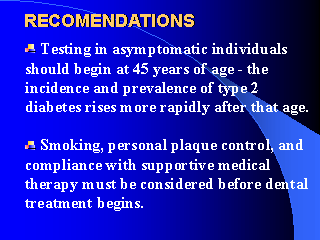|
|
|
|
front |1 |2 |3 |4 |5 |6 |7 |8 |9 |10 |11 |12 |13 |14 |15 |16 |17 |18 |19 |20 |21 |22 |23 |24 |25 |26 |27 |28 |29 |30 |31 |32 |33 |34 |review |
 |
The most common form of diabetes is Type 2 diabetes. About 90 to 95 percent of
people with diabetes have Type 2 diabetes. This form of diabetes usually
develops in adults over the age of 40 and is most common among adults over age
55. About 80 percent of people with Type 2 diabetes are overweight. In Type 2
diabetes, the pancreas usually produces insulin, but for some reason, the body
cannot use the insulin effectively. The end result is an unhealthy buildup of
glucose in the blood and an inability of the body to make efficient use of its
main source of fuel. The symptoms of Type 2 diabetes develop gradually and are
not as noticeable as other chronic diseases. Symptoms include feeling tired or
ill, frequent urination (especially at night), unusual thirst, weight loss,
blurred vision, frequent infections, and slow healing of wounds.
The goal of diabetes management is to keep blood glucose levels as close to the normal range as safely possible: Patients should be encouraged to achieve a fasting glucose of less than 120 mg/dL with two-hour postprandial glucose concentrations of less than 160 mg/dL, but ideally less than 140 mg/dL. A recent government study, sponsored by the National Institute of Diabetes and Digestive and Kidney Diseases (NIDDK), demonstrated that keeping blood sugar levels as close to normal as safely possible reduces the risk of developing major complications of diabetes mellitus. Thus far, this lecture suggests that the demand for dental services will be a critical issue in the planning of future dental public health services along the United States-Mexico border. Diabetes mellitus is a risk factor for oral diseases. Accordingly, the dental practitioner must be able to identify individuals with undiagnosed diabetes who present with an oral complaint as the primary manifestation of their disorder. If the diagnosis is overlooked, the oral symptoms may not respond to conventional therapy. Moreover, the need for oral health services is compounded by the special health care requirements of a growing elderly population living along the U.S.-Mexico border area that is at risk for Type 2 Diabetes Mellitus. Chronic diseases and the effects of multiple medications on oral health often compound the oral health problems of the elderly. Oral health is an integral part of total health and since medically complicated or compromised patients, particularly Mexican-American women, will most likely become a significant proportion of future border-patient population, additional knowledge of dental public health as well as systemic diseases and medical intervention will become more essential in future dental public health research, clinical applications, planning, and policy making. |